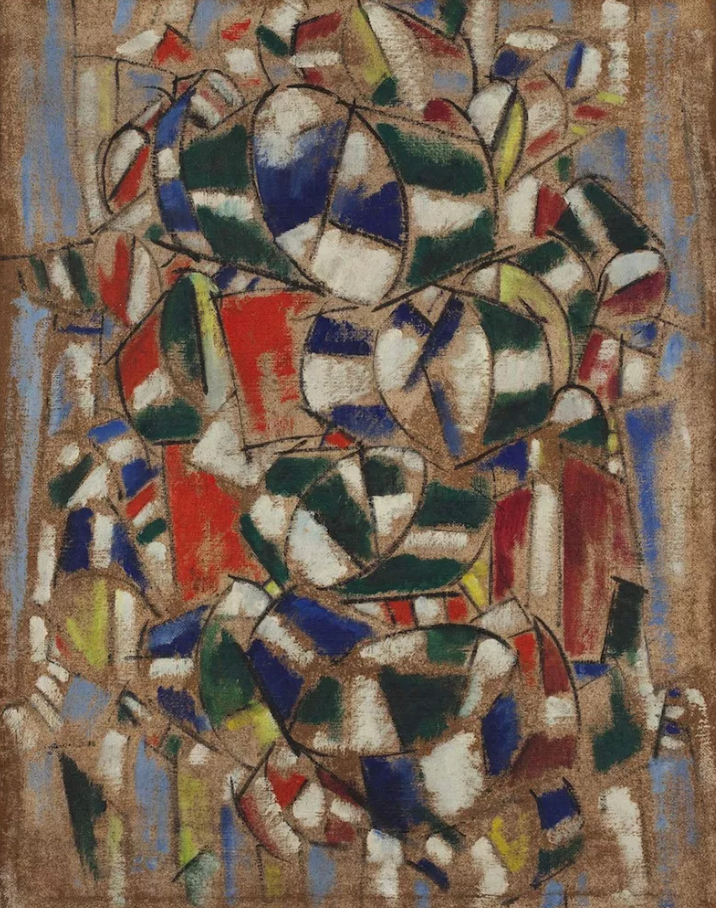How Atomic Bombs Blew Up the Counterfeit Art World

Pictured above is… well, it’s not quite clear. But it probably isn’t worth a lot — much to the chagrin of the curators of Manhattan’s Guggenheim Museum. Because the image is not an oil on canvas by French painted Fernand Léger.
But until somewhat recently, no one knew that — not, at least, until the physicists got involved.
Léger’s career spanned decades, and over those years, his work changed dramatically. During the early 1910s, his paintings were very abstract — here is an example of his (actual) work from 1912 — but as times changed, so did his approach to the visual arts. As Wikipedia notes, “starting in 1927, the character of Léger’s work gradually changed as organic and irregular forms assumed greater importance.” Those earlier works, though, are worth a fortune: the linked-to 1912 work sold at auction in May of 2008 for more than $35 million.
Sometime after World War II, famed art collector Peggy Guggenheim (a niece of Solomon Guggenheim, who established the Guggenheim Museum) acquired the painting above, believing it to be an original Léger. The museum displayed the work until the 1970s and would have continued to do so. But at some point during that decade, according to LiveScience, “Léger scholar Douglas Cooper voiced serious skepticism about its authenticity.” Other experts were undecided on the painting’s authenticity so, in an effort to not mislead the public, the museum decided to no longer display the work nor include or list it as part of the museum’s collection.
The work effectively gathered dust for a few decades until the science community stepped in with a solution: carbon testing. As Gizmodo explains, “the world’s nuclear nations exploded 550 nuclear weapons during tests between the years of 1945 and 1963 when the Limited Test Ban Treaty outlawed all above-ground detonations.” And in doing so, the amount of an unstable carbon isotope, carbon 14, increased dramatically during that period. “In fact,” notes the New York Times, “so much carbon 14 had been created in the decade or so leading up to the signing of the partial nuclear test ban treaty of 1963 that levels in the atmosphere virtually doubled.” And the carbon in the atmosphere also made its way into all of the stuff made during that time period — including paintings.
In 2014, the Guggenheim had the amount of carbon 14 in the painting tested. And the results made it clear: it wasn’t a legit Léger. Per Artnet, “the testing was performed on a small piece of the cotton canvas by the Italian Institute for Nuclear Physics. An electrostatic accelerator found high carbon levels that would only be present if the work was from 1959 or later, proving the piece cannot be part of the original series. Nor is it a later work by the artist, as Léger died in 1955.”
The Guggenheim, in a statement about the finding, thanked the Institute and that “the cloud of uncertainty has at last been lifted and Douglas Cooper’s connoisseurship vindicated.” The whereabouts of the fake artwork has gone unreported.
Bonus fact: In 2016, the Guggenheim introduced a new piece to its collection — and to see it, you had to visit the restroom. The piece, titled “America,” was “a working toilet cast from gold that has been installed in a bathroom on the museum’s fifth floor,” per the museum’s website. The artist, Italian Maurizio Cattelan, “intend[ed] visitors to use the toilet just as they would any other facility in the building.”
From the Archives: An Unreal Art Caper: Art fraud gone lazy?
